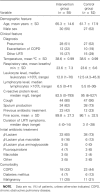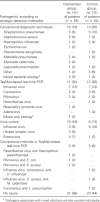Impact of rapid detection of viral and atypical bacterial pathogens by real-time polymerase chain reaction for patients with lower respiratory tract infection
- PMID: 16231254
- PMCID: PMC7107964
- DOI: 10.1086/497134
Impact of rapid detection of viral and atypical bacterial pathogens by real-time polymerase chain reaction for patients with lower respiratory tract infection
Abstract
Background: Rapid diagnostic tests with a high sensitivity for lower respiratory tract infection (LRTI) could lead to improved patient care and reduce unnecessary antibiotic use and associated costs. Diagnostic yields, feasibility, and costs of real-time polymerase chain reaction (PCR) of nasopharyngeal and oropharyngeal swab specimens in the routine diagnostic work-up for LRTI were determined.
Methods: In a randomized controlled trial, nasopharyngeal and oropharyngeal swab specimens from patients admitted for antibiotic treatment of LRTI were evaluated by means of real-time PCR for respiratory viruses and atypical pathogens, as well as by conventional diagnostic procedures. Real-time PCR results for patients in the intervention group were reported to the treating physician; results for patients in the control group were not made available.
Results: A total of 107 patients (mean age [+/- standard deviation], 63.6+/-16.3 years) were included, of whom 55 were allocated to the intervention group. The pathogens detected most frequently were influenza virus (14 patients), Streptococcus pneumoniae (8), coronavirus (6), Staphylococcus aureus (5), and rhinoviruses (5). Real-time PCR increased the diagnostic yield from 23 cases (21% of patients) to 47 cases (43% of patients), compared with conventional diagnostic tests. The detection of viral pathogens by PCR was associated with the winter season, less infiltrates on chest radiographs, lower C-reactive protein levels, and shorter duration of symptoms. Use of real-time PCR results resulted in partial or total cessation of antibiotic treatment for 6 patients (11%; 95% confidence interval, 2-19), but overall antibiotic use was comparable in the intervention group and the control group (median duration of treatment, 10.0 vs. 9.0 days; P=not significant). Use of real-time PCR increased treatment and diagnostic costs with 318.17 per patient.
Conclusions: Implementation of real-time PCR for the etiological diagnosis of LRTI increased the diagnostic yield considerably, but it did not reduce antibiotic use or costs.
Figures




Comment in
-
Impact of rapid microbiological testing on the management of lower respiratory tract infection.Clin Infect Dis. 2005 Nov 15;41(10):1445-7. doi: 10.1086/497145. Epub 2005 Oct 13. Clin Infect Dis. 2005. PMID: 16231255 No abstract available.
References
-
- Pneumonia and influenza death rates—United States, 1979–1994. MMWR Morb Mortal Wkly Rep. 1995;44:535–7. - PubMed
-
- Guest JF, Morris A. Community-acquired pneumonia: the annual cost to the National Health Service in the UK. Eur Respir J. 1997;10:1530–4. - PubMed
-
- Marston BJ, Plouffe JF, File TM, Jr, et al. Incidence of community-acquired pneumonia requiring hospitalization: results of a population-based active surveillance study in Ohio. The Community-Based Pneumonia Incidence Study Group. Arch Intern Med. 1997;157:1709–18. - PubMed
-
- Thompson WW, Shay DK, Weintraub E, et al. Mortality associated with influenza and respiratory syncytial virus in the United States. JAMA. 2003;289:179–86. - PubMed
Publication types
MeSH terms
Substances
LinkOut - more resources
Full Text Sources
Other Literature Sources
Medical
Research Materials

